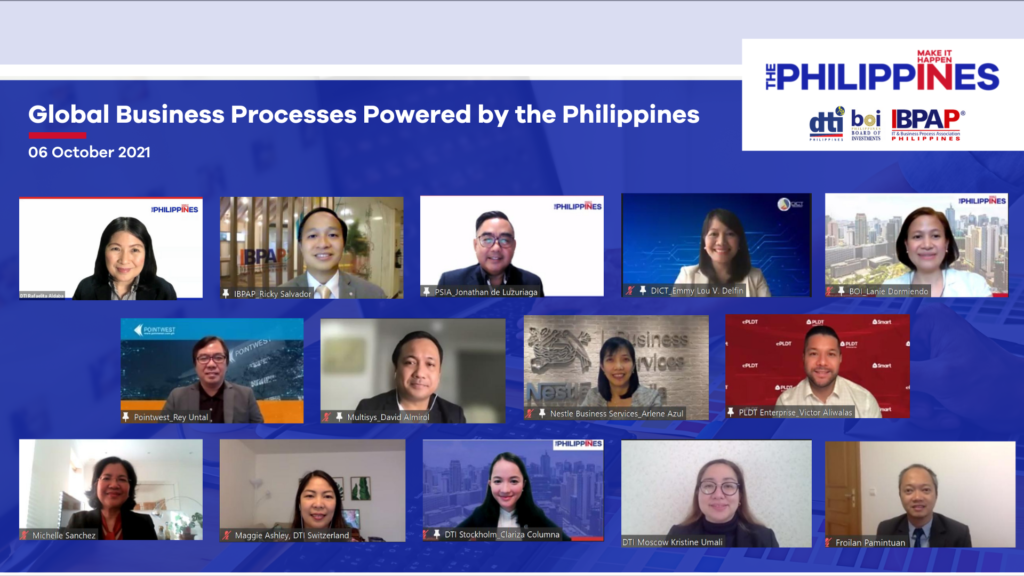
The country’s information technology-business processing management (IT-BPM) sector, which showed remarkable resilience in the middle of the health crisis, remains a bright spot in the post-pandemic recovery where it continues to drive growth, create future-ready jobs, and generate positive multiplier effects in the local economy, government officials and industry representatives said during a webinar on 6 October 2021.
While the pandemic dented the growth outlook of several industries, the IT-BPM industry, which is countercyclical in nature, saw revenues rise 1.4% YoY to USD26.7-B and headcount hit 1.32 million in 2020, according to the IT and Business Process Association of the Philippines (IBPAP), the country’s IT-BPM industry association. The industry was among the essential activities allowed to operate during the lockdowns.
“The Department of Trade and Industry (DTI) initiatives are geared towards helping our companies shift towards industry transformation. We see digital transformation as a journey towards embracing a culture of innovation in all facets of production– people, technology and organization. The Department is working with government, education agencies as well as with industries and academe, including tech-voc institutions in formulating our skills development framework to prepare our workforce for the jobs of the future and ensure that the skills demanded by companies would be sufficiently provided,” underscored by Usec. Rafaelita M. Aldaba of the Competitiveness and Innovation Group of the Department of Trade and Industry.
“We navigated the pandemic a year ago, the entire industry had been able to clear virtually overnight from the brick-and-mortar set-up to a fully hybrid model.” Said Pointwest Technologies President Rey Untal. “In a week’s time, everyone was working virtually… and we are at the cusp right now of operationalizing a longer-term vision in terms of this hybrid model.”
“The transition from on-site to work from home was one of our biggest challenges. We immediately need tens of thousands or 5000 work-from-home LTE or 5G devices and repurposing our enterprise grade fiber to the work from home situation.” Said PDLT ALPHA Enterprise Vice President Victor Aliwalas. “With all the investments that we spent in 2020-2021, we ensure that we can support the industry, to really understand the issues are so we can be sure that we allocate those investments to support those needs.”
Before it grew to be a core engine of the Philippine economy, the IT-BPM industry started with basic encoding, IT programming, and in-house development in the 1980s, setting up of shared service operations in the 1990s and by the early 2000s, voice-related services provided by call centers took off. The Philippines emerged as a preferred destination for call centers like Convergys, Sykes, and Telus which cumulatively employ 103,000 full-time employees. Today, the country commands the largest market share in the voice segment and second in non-voice services, which covers IT support and back-office work capitalizing on the rich talent pool in the country. In 2010, the IT-BPM industry expanded from voice-based services into more complex subsectors like animation, game development, global shared services, healthcare, IT and software.
“These companies set up shop or locate in the country because of some very key competitive advantages. Over the years the Philippine IT-BPM sector has been developing capabilities not just in transactional and horizontal functions such as IT, HR and F&A, but also in more complex and core functions including supply chain management, banking operations and marketing. This has made the Philippines an important hub for the BSFI sector with the presence of very large global banks,” said Salvador.
The IT-BPM industry has the strong potential to expand at a compound annual growth rate (CAGR) of 5.5% in revenue and 5% in headcount from 2020-2022, translating to USD29-B in revenues and over 130,000 in employment.
“To support to the IT-BPM industry, through our consultations with the subsector associations such as the Animation Council of the Philippines and the Philippine Software Association, the Department of Information and Communications Technology allocated funds for the upskilling and reskilling of employees starting this year,” according to DICT Director Emmy Lou Delfin. Further, the Department is also implementing the Digital Cities 2025 Program which identified 25 locations as the center of focus for new developments to become the next business destinations for IT-BPM operations.
While the industry traditionally largely caters to the North American market, there has been an increasing interest from other parts of the world. Currently, more than 10% of the Philippines’ IT-BPM revenues comes from Europe. Companies like Nestlé, Ubisoft and other notable multinational companies have established their global and regional in-house and shared services hubs in the country, according to Board of Investments Director Lanie Dormiendo.
“For the European region, we have around 25 companies that we have been assisting the past years on various levels of engagement, interested in setting up shop the Philippines. We have a newly implemented incentives regime which is rationalized and modernized to be responsive to the needs of the industry particularly the IT-BPM sector.“ added Dormiendo.
IT-BPM is a priority sector under the Make it Happen in the Philippines investment promotion campaign, together with aerospace, automotive, copper, and electronics. PH is a top tier destination for IT-BPM outsourcing and one of the leaders in the industry. Ranking 1st in voice and accounting for 13 global market share.
The webinar was organized by the Department of Trade and Industry, the Board of Investments, and IBPAP, as part of an ongoing effort to attract foreign investments into targeted sectors.
♦ Date of Release: 11 October 2021


